Beginner’s Guide to Sautéing: Simple Tips and Tricks

Start a cooking journey in your kitchen by learning to sauté. It’s a key skill for any cook. “Sauté” comes from the French word for “to jump,” making cooking seem like a fun dance of food. Learn sautéing techniques for beginners to turn simple ingredients into amazing meals. These tips will help, whether you’re new or already know high-heat cooking basics like pan-frying.
We’ll show you how to make tasty and healthy sautés easily. Picking the right pan and learning sautéing methods are important. With our help, you’ll bring out the best tastes in your dishes. Ready to heat things up? Let’s explore the key steps for great sautéing.
Key Takeaways
- The foundational aspects of sautéing include using a high-heat and a small amount of oil or fat for rapid cooking.
- Choosing the correct sauté pan—usually wide, shallow, and with straight sides—is crucial to the technique.
- Select oils with high smoke points, like vegetable oil and canola oil, or opt for richly flavored ghee for healthy sautéing.
- Uniformly chopping ingredients ensures even cooking and promotes the development of rich flavors and textures.
- Avoid common pitfalls such as overcrowding the pan and using too much oil to achieve the perfect sauté every time.
- Learn the differences between sautéing and other cooking methods to broaden your culinary repertoire and impress with every dish.
What is Sautéing?
Sautéing is a key cooking skill that combines fast cooking with a little fat. It makes the cooking faster and improves the food’s taste and feel. In sautéing, you cook food quickly in a wide pan over medium-high heat, using a bit of fat. This creates a tasty sear without needing to deep fry.
Definition and Basics
Sautéing means cooking food in a tiny amount of oil or fat over high heat. This method is common among sautéing techniques for beginners. It usually involves stirring the food fast. This fast cooking leads to the Maillard reaction, which browns the food and adds flavor. Foods are cut evenly to cook uniformly, making it great for mixed dishes.
The Importance of Heat Control
Learning sautéing techniques for beginners is all about managing the heat. The pan needs to be hot for searing but not so much that it burns the food. Cooking quickly in a small amount of fat, like oils with a high smoke point, helps the food caramelize. This method keeps the food nutritious and makes it rich and flavorful.
Essential Tools for Sautéing
Diving into the sautéing world means the right tools are crucial. Both seasoned chefs and beginners need the right equipment. This makes cooking smoother, more efficient, and fun. Let’s look at the essential cookware and utensils for sautéing.
Must-Have Cookware
A top-quality sauté pan is key for sautéing. These pans have a wide base and straight sides for quick, high-heat cooking. Choose pans made of stainless steel or PFOA-free nonstick material for safe and flavorful cooking.
Stainless steel pans are great for browning food without adding unwanted flavors. For sticky ingredients or delicate dishes, a nonstick sauté pan works best.
Recommended Utensils
Choosing the right utensils protects your pans and helps with cooking precision. Use tools like silicone spatulas, wooden spoons, or stainless-steel tongs. These won’t scratch your cookware and keep it in good shape for many meals.

We’ve compared kitchen utensils for sautéing, from budget-friendly to upgrade options:
| Utensil | Budget Pick | Upgrade Pick |
|---|---|---|
| Chef’s Knife | $19 at Amazon | $170 at Amazon |
| Serrated Bread Knife | $18 at Amazon | $49 at Amazon |
| Petty Knife (Utility Knife) | $15 at Amazon | $60 at Amazon |
| Cutting Board | $12 at Amazon | $240 at The Boardsmith |
| Wooden Spoon | $10 at Amazon | — |
| Sturdy Spatula | $11 at Amazon | — |
| Fish Spatula | $12 at Amazon | $65 at Amazon |
| Tongs | $16 at Amazon | — |
Starting with the right tools is the first step to mastering sautéing. High-quality pans and the best utensils are key. With these, creating great meals becomes easier and more enjoyable.
Choosing the Right Ingredients
Mastering the art of sautéing begins with choosing the right ingredients. You can sauté veggies or meat, but knowing which ones to use makes a big difference.
Best Vegetables for Sautéing
Some vegetables shine when sautéed. Look for veggies that handle high heat well, like zucchini, bell peppers, cauliflower, and brussels sprouts. These veggies become sweet and complex when sautéed because of the Maillard reaction. Cutting them into even pieces ensures they cook uniformly and taste amazing.
Protein Selections for Sautéing
Selecting the right meat is crucial for sautéing. Sliced chicken breast and skirt steak are top choices. They cook quickly and evenly when cut into strips. Make sure your meat pieces are the same thickness. This leads to better looks and consistent cooking. It helps avoid any parts being under or overcooked, making your dish taste and look good.
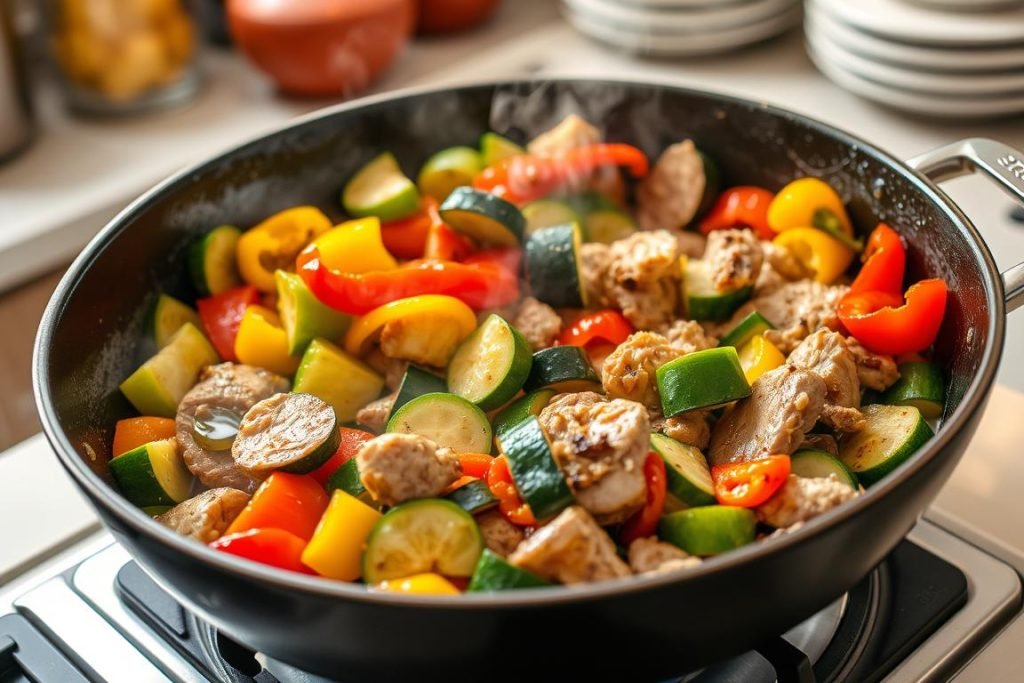
Mixing vegetables and meats can create a dish that’s full of color, flavor, and texture. The trick to a great sauté is balancing the ingredients well. Everything works together to make a dish that’s truly special.
Preparing Your Ingredients
Before you start sautéing, it’s key to ready your ingredients well. This adds flavor and ensures they cook evenly. Getting ready for high-heat cooking means focusing on how you prepare. Paying attention here makes your dishes better.
Chopping Techniques
To sauté well, cut everything into even pieces. This makes your dish look good and cook right. If pieces are different sizes, they won’t cook the same. Some might be overdone, while others are not.
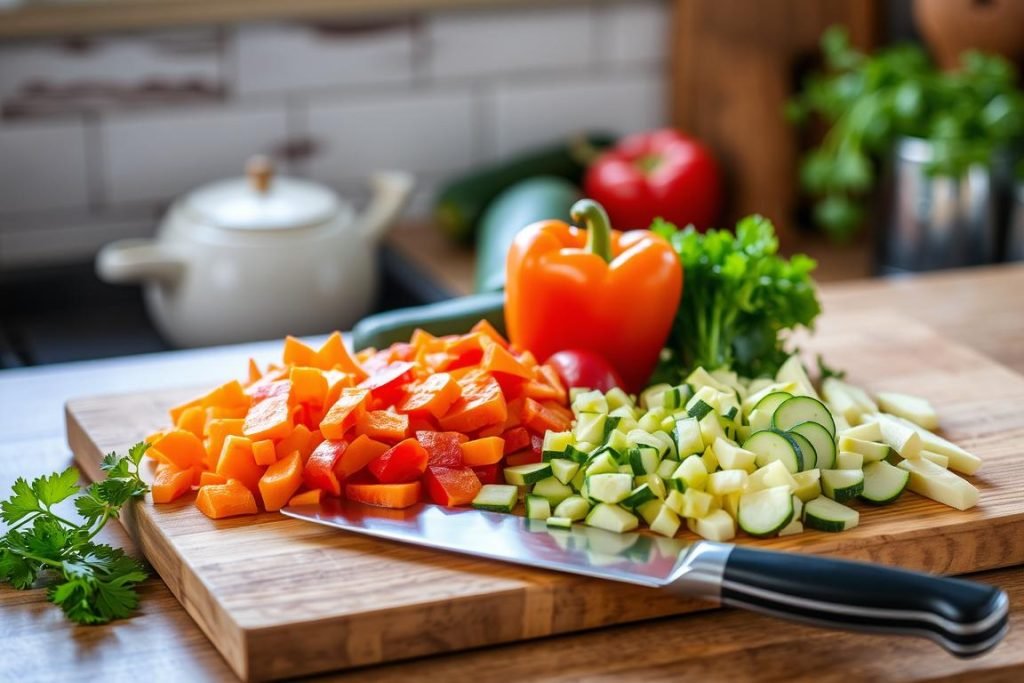
Marinating for Flavor
Marinating adds a lot of taste to your dishes. It works great for both meats and veggies. Using good oils or herbs before cooking can bring out strong flavors.
Here are some tips to enhance your cooking:
- Dry ingredients after marinating by using a paper towel. This is needed to sauté instead of steam them. Moisture can make the pan too cool, which affects taste.
- Choose oils like corn oil which don’t overpower your food. They have a high smoke point, perfect for sautéing.
These steps prepare you for excellent high-heat cooking. How you ready your ingredients affects your food’s flavor and quality.
The Sautéing Process Step-by-Step
To master sautéing, you need to know each step. It’s a cooking method that requires high heat and quick actions. This ensures the food tastes great and is cooked just right.
Preheating Your Pan
Start with the right pan. A heavy-bottom skillet works best. Heat it on medium-high if it’s stainless steel, or medium for nonstick. A drop of water will dance on it when it’s hot enough. This is key for successful pan-frying.
Adding Oil and Starting to Sauté
After heating the pan, add some oil. Wait until it shimmers. This means it’s ready. If oil is added too early or is too hot, food may cook unevenly or burn. Then, put your seasoned, dry ingredients in, spreading them out. Avoid putting too much so everything cooks the same. This ensures each piece gets a nice sear instead of steaming.
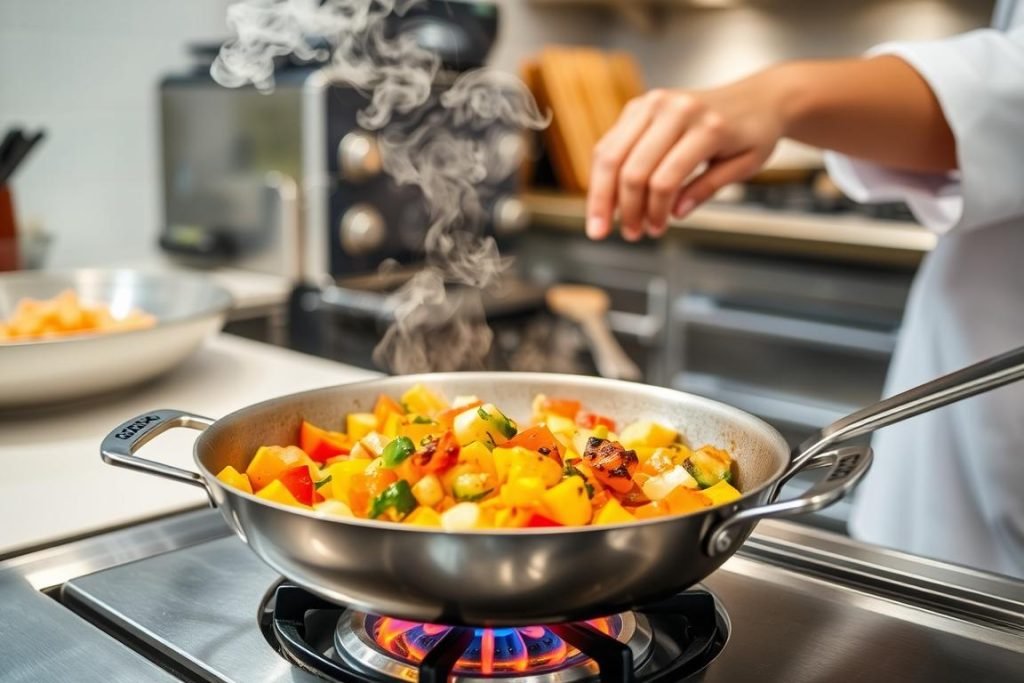
Stir your food the right amount. Stirring too much won’t let it sear well. Use the pan’s sides to flip and toss. This cooks everything evenly and mixes flavors well.
| Cooking Action | Importance | Professional Tip |
|---|---|---|
| Preheating | Ensures pan has reached ideal temperature for sautéing | Use the water test: A drop should ball up, not evaporate |
| Adding Oil | Creates a non-stick surface and conducts heat evenly | Wait for the oil to shimmer before adding ingredients |
| Laying Ingredients | Avoids steaming and ensures crispness | Place ingredients in a single layer for uniform cooking |
| Flipping Techniques | Fosters even browning and flavor development | Use the pan’s rounded sides to flip ingredients gently |
Following these steps helps you cook with precision and care. It’s the base for a great sauté every time. Properly adding oil and controlling the heat are essential.
Common Mistakes to Avoid
Starting to master sautéing? Watch out for errors that affect taste and texture. Knowing these mistakes improves your dish quality and makes cooking fun.
Overcrowding the Pan
For successful sautéing, give your ingredients enough space. Too many novices crowd the pan, leading to steamed, not sautéed, food. This means no golden crispiness. To fix this, cook in batches so each piece can properly brown.
| Food Type | Space Needed for Optimal Browning | Common Mistake |
|---|---|---|
| Meat (Diced) | Single layer, pieces not touching | Chunks too close, causing moisture buildup |
| Vegetables (Sliced) | Enough room to flip easily | Piling in layers, leading to uneven cooking |
Ignoring Temperature Settings
Choosing the right temperature is key for sautéing. It sears proteins and veggies quickly, trapping in flavors. Always heat the pan to around 330°F before adding fat. Avoid adding oil to a cold pan or overheating, which ruins the food.
Beginner-friendly sautéing recipes suggest using butter and high smoke point oil, like canola. This combo adds taste and is practical. High smoke point oils, like peanut (440°F) or canola (400°F), prevent burning.

Learning about mistakes, from pan overcrowding to wrong temperatures, betters your cooking. This awareness leads to tastier dishes and more kitchen joy.
Flavor Enhancements
Exploring sautéing can majorly boost your cooking game. It’s key for enhancing flavors. We’ll cover essential seasoning techniques and using aromatics. These skills are crucial for making your food taste amazing. They don’t just add flavor. They also make your meals more interesting.
Seasoning Techniques
Knowing how to season is basic but vital in cooking. When sautéing, adding seasonings at the right time makes a big difference. Take salt, for example. Adding it early helps spread its flavor throughout. Also, dry roasting spices before using them pulls out more of their scents. This trick makes your food taste better.
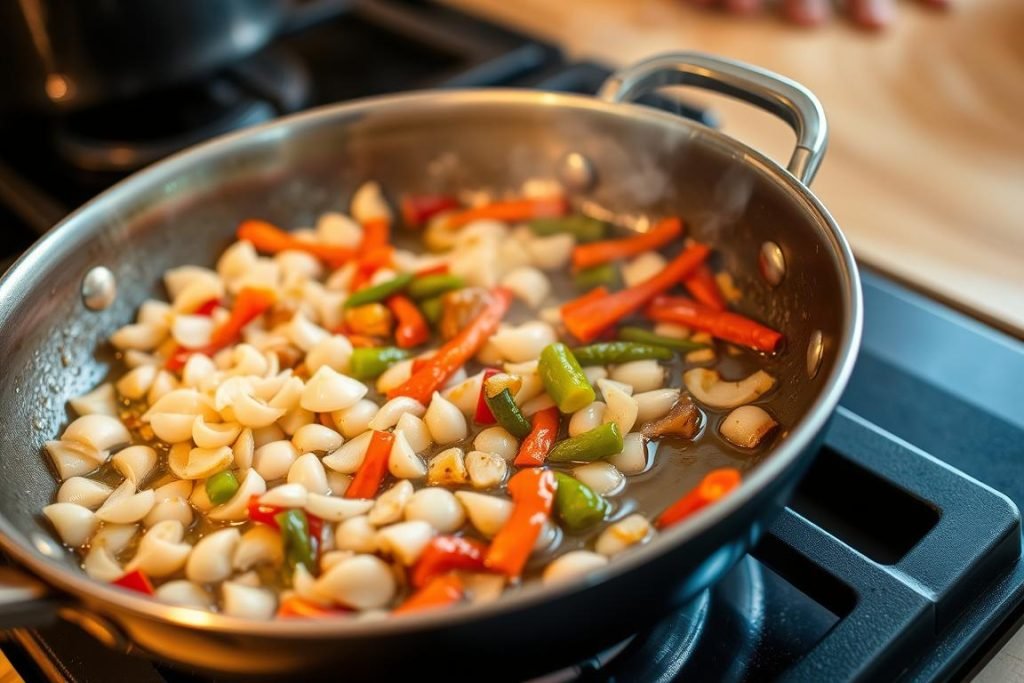
Incorporating Aromatics
Aromatics like onions, garlic, and herbs are key for flavor. To use them right, cook them until they’re just right. Doing so releases their flavors into the oil. This step makes your whole dish taste better. Cooking onions until golden adds sweetness. Lightly cooking garlic gives depth without bitterness.
These sautéing tips for beginners will improve your cooking. It’s about managing the heat and adding seasonings wisely. With practice, you will get better at making delicious, aromatic dishes.
Timing and Texture
Sautéing is an art where timing and texture are key. They decide if your dish will be a success. Learning about these elements can make your cooking better.
Knowing When Ingredients are Done
Knowing when ingredients are done is key for tasty and pretty sautéed dishes. Vegetables should be soft yet crisp, and meats need to be safe to eat. Use a kitchen thermometer and your senses to check if they’re ready.
For example, onions should sauté for about 5 minutes. This makes them sweet but not mushy. Look for edges that are just turning golden as a sign they’re done.
Achieving Perfect Crunch
For that perfect crunch, the right heat and timing are important. Cook quickly on high heat but don’t overdo it. Make sure the pan is hot before adding your ingredients for a quick sear.
Vegetables like green beans and bell peppers are best when cooked fast on high heat. This keeps their crunch and color. You can tell they’re done if they resist a bit against a spatula.
Below is a table with cooking times for a couple of common ingredients:
| Ingredient | Texture Goal | Recommended Cooking Time |
|---|---|---|
| Onions | Translucent with slight golden edges | 5 minutes |
| Green Beans | Tender-crisp | 3-4 minutes |

Mastering sautéing means knowing how and when to stop cooking. With these tips on timing and texture, you’re ready to improve your sautéing and add variety to your meals.
Healthier Sautéing Options
Learning healthier cooking methods like sautéing can upgrade your diet and keep meals tasty. This guide shows you how to sauté in a healthy way. It focuses on reducing oil and using whole foods. These tips help make your meals both nutritious and delicious.
Using Less Oil
To use less oil, pick an oil that withstands high heat. Avocado oil or grapeseed oil are good options. They don’t burn easily. Always measure the oil with a teaspoon instead of pouring it. This ensures using just the right amount. Also, a good non-stick skillet requires less oil, which helps.
Using just enough oil for the pan and ingredients makes food less greasy and healthier.
Incorporating Whole Foods
Sautéing keeps the goodness in whole foods. Start with bright veggies and lean proteins. The table below helps with cooking times. It ensures veggies stay tasty and crunchy.
| Vegetable | Preparation | Cooking Time |
|---|---|---|
| Carrots, Sweet Potatoes | Start first | Up to 10 minutes |
| Onions, Peppers, Mushrooms, Zucchini | Add after heartier veg | 5-7 minutes |
| Spinach, Kale | Add last | 2-4 minutes |
For extra flavor, add garlic in the last 30 seconds. A splash of soy sauce or your favorite sauce also adds a kick. This lifts the flavor of your sauté.
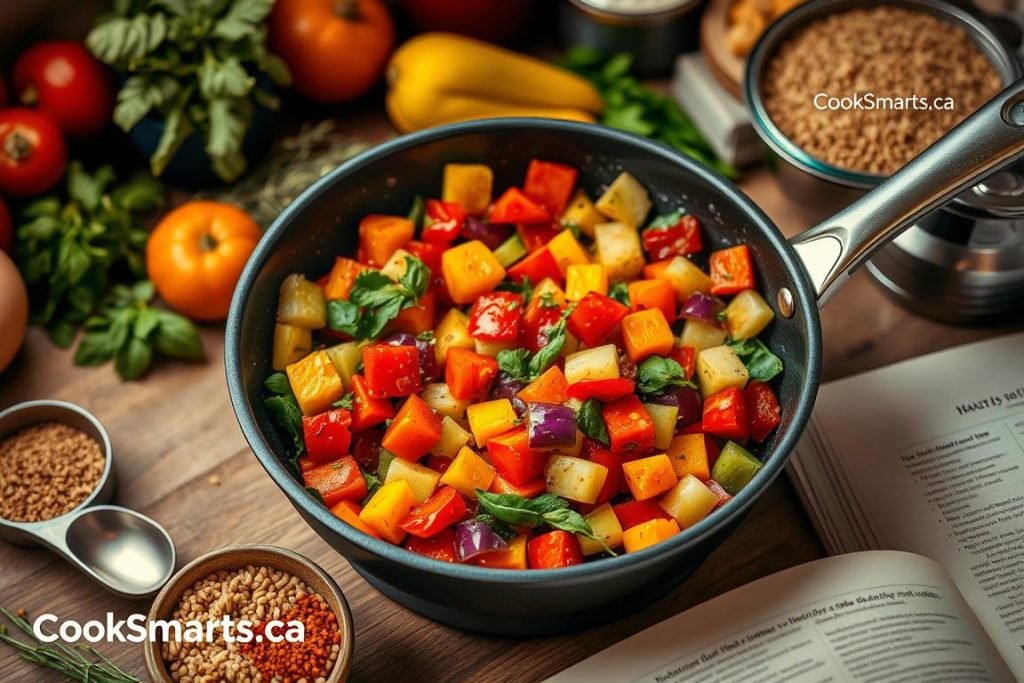
Healthy sautéing isn’t just about using less oil. It’s also about choosing better food. Mix in lots of whole foods like beans, grains, and various veggies. This turns your sauté into a nutrient-filled meal. Keep these tips in mind for meals that are both healthy and tasty.
Sautéing Recipes for Beginners
Starting to sauté can feel exciting and a little scary for beginners. Yet, with easy-to-follow sautéing recipes, you can learn to make tasty dishes fast. Try beginning with a basic vegetable medley to learn about heat control and seasoning. This can help you make delicious and healthy meals. For a bit of a challenge, try sautéing chicken and broccoli together. It teaches you how to cook meat and veggies so they come out perfect, flavor-packed, and great for any meal time.
Simple Vegetable Medley
This veggie dish is both healthy and colorful, packed with vitamins and fiber, and low in calories. You’ll need just a few ingredients like olive oil, garlic, bell peppers, squash, and zucchini. Plus, a bit of seasoning. Start by sautéing carrots and onions, then add the other veggies. Zucchini goes in last to stay crisp. Using olive or avocado oil adds flavor and healthy fats to your dish.
Finish the dish with smoked paprika or Italian seasoning for extra taste. This method makes mastering the sauté technique easy and enjoyable.
Quick Chicken and Broccoli Sauté
For a protein-filled meal, try the chicken and broccoli sauté. It’s a one-pan dish that balances cooking times for chicken and broccoli. It shows how to keep chicken tender and broccoli crispy and tasty. This meal is not only delicious but also nutritious, offering lots of protein.
Once cooked, you can keep this sautéed dish in the fridge for up to 4 days. Use a non-stick or cast iron skillet for the best sauté.
These recipes, whether a veggie medley or chicken and broccoli, are great for beginners. They suit different diets and tastes, can be tweaked easily, and show that cooking a healthy, tasty meal can be simple and fun.